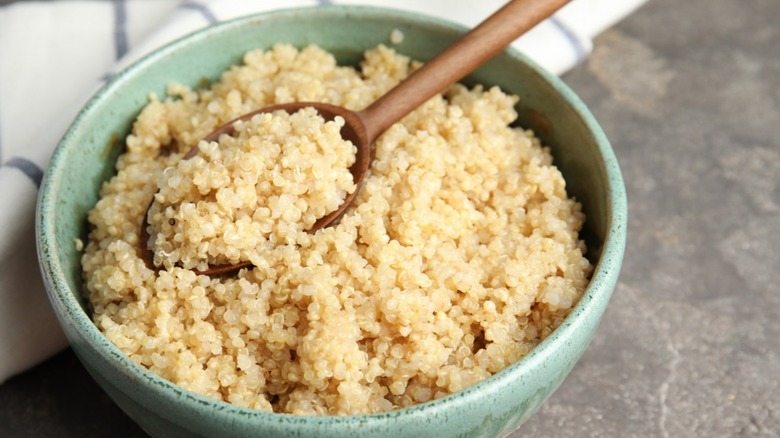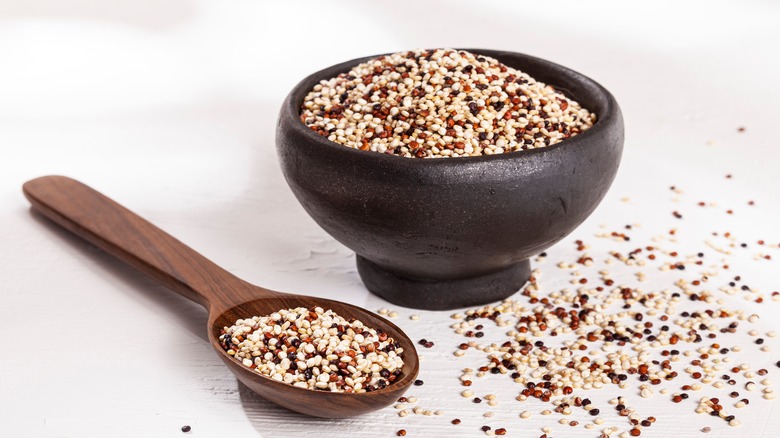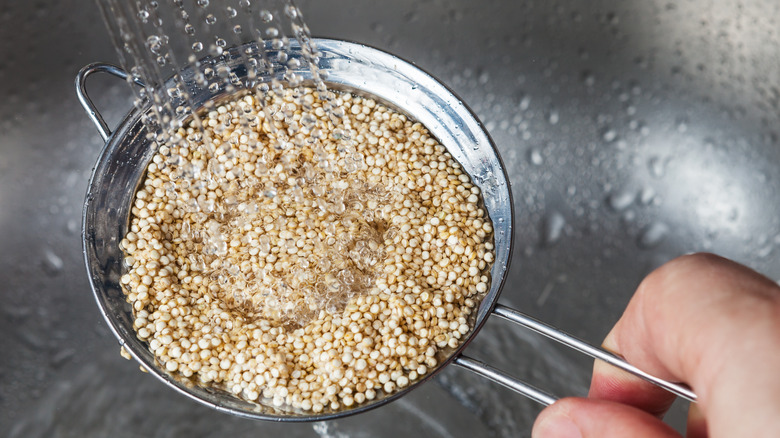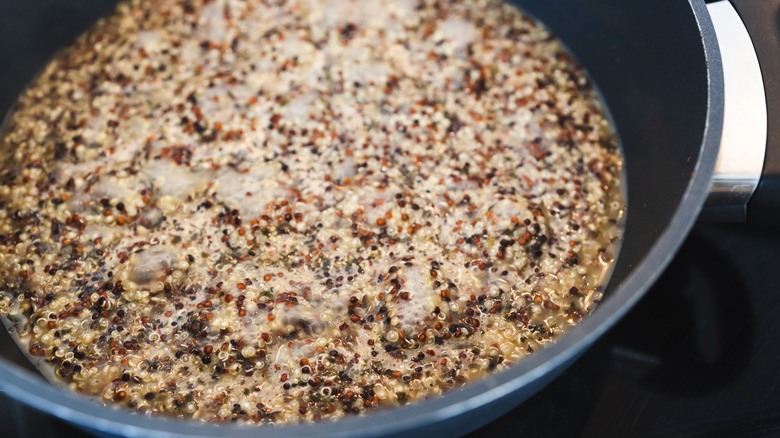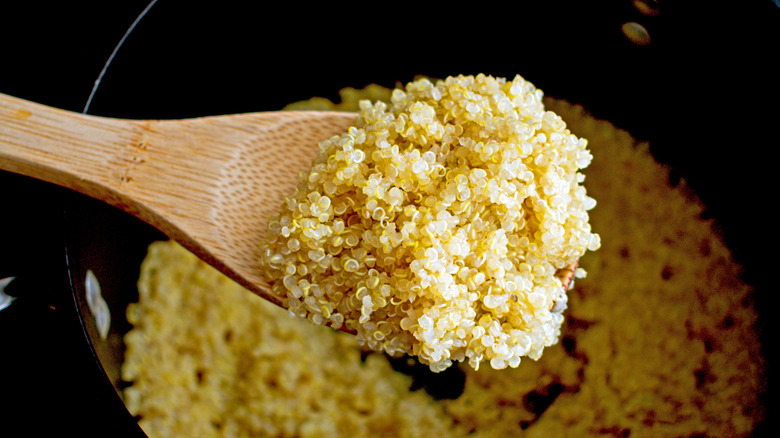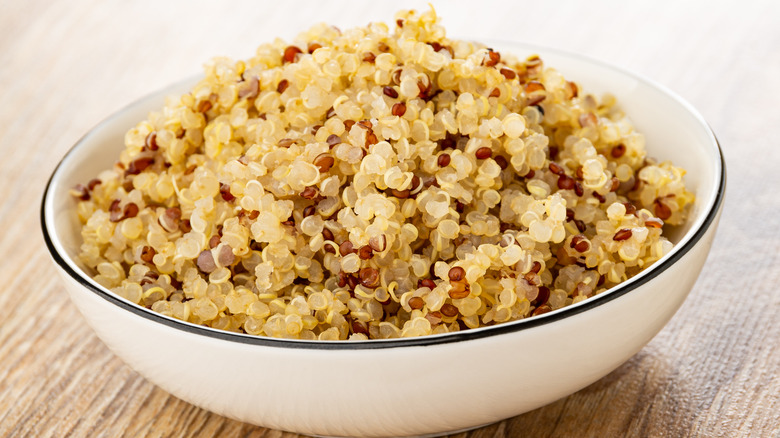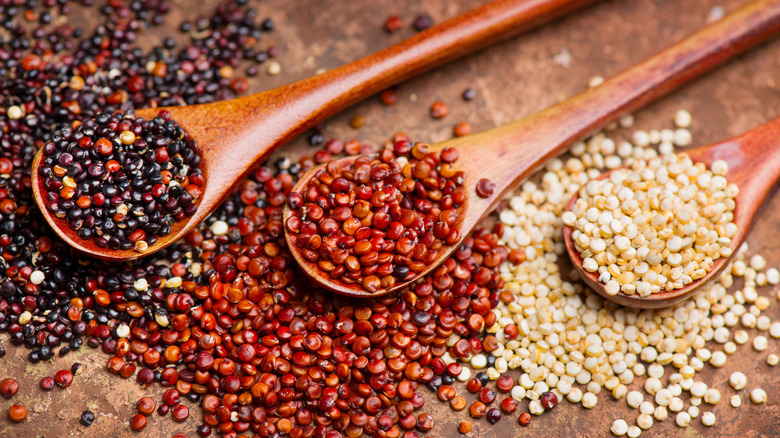Mistakes Everyone Makes With Quinoa
Quinoa is packed with plant-based protein, fiber, and several essential micronutrients like magnesium and folate, according to Harvard Health. This means the food is an excellent ingredient for bulking up a vegetarian or vegan dish and helps us reach those daily fiber and micronutrient recommendations that many living in the U.S. miss out on. When cooked properly, quinoa can be a delicious addition to salads or veggie burgers and makes for a versatile side dish ... unfortunately, quinoa is often poorly cooked at home due to some common mistakes in the kitchen.
The good news is that cooking quinoa really isn't difficult, it just requires a few more steps than many home cooks are aware of (or are willing to put in) when trying to get dinner on the table. Knowing the following quinoa mistakes will help you develop a better understanding of this ever-popular food and become more equipped to bring out its fullest potential as a nutty, wholesome, and satisfying food.
Thinking quinoa is a new, trendy food
While quinoa may have really hit its stride in the last 10 years or so in the United States, it has been a staple food in South America — particularly in Chile, Bolivia, and Peru — for thousands of years. Beloved baking and pantry staple brand Bob's Red Mill explains that the Incas considered quinoa a "mother grain" and "a sacred seed."
Yes, quinoa is actually a seed, or pseudocereal, and not a whole grain, although it often gets categorized as one. Bob's Red Mill says quinoa is the seed of the Chenopodium plant, in the same family as veggies like spinach, chard, and beets. Quinoa is cooked like rice and other whole grains, getting a similar treatment to other pseudocereals like amaranth and buckwheat.
Though only semi-recently cementing itself as a superfood in North America, this "sacred seed" has remained popular among people living in the Andes Mountains for millennia. There are probably more recipes featuring quinoa than you could cook in a lifetime, so don't shrug the ingredient off as some "health food hipster trend."
Not rinsing your quinoa before cooking
Too many home cooks skip the first step listed on the cooking instructions of most bags of quinoa: rinsing. You'll need to use a fine mesh sieve instead of a colander for your quinoa, as it's much smaller and more seed-like than most other grains.
Ancient Harvest, a brand that sells products made from whole, ancient grains, explains why this step is so important. The company says that quinoa has a natural chemical compound coating, called saponins, which are likely present to protect quinoa (and other plants) from microbes, fungi, and animals. Saponins have a bitter component to repel these animals, and that includes humans. Some people are more sensitive to saponins than others, but most home cooks will agree that rinsing quinoa before cooking improves the flavor significantly without any extra skills or ingredients. Even if your bag of quinoa boasts being "pre-washed," culinary scientist Jessica Gavin advises rinsing it anyway.
Forgetting to salt quinoa before bringing it to a boil
While it may seem like no big deal to salt your pot of quinoa after cooking, following Whole Foods Market's guidance on salting before bringing it to a boil will ensure your dish is evenly seasoned. The Kitchn advises using ½ teaspoon of kosher salt for every cup of quinoa you're cooking, and you can also replace some of the water with broth for an extra dose of savoriness and flavor.
The best part of enjoying a home-cooked meal is that it's made exactly to your liking, so don't be afraid to experiment with different ratios, so long as you're following each important cooking step. If you prefer cooking with a specific type of salt, such as sea salt or Himalayan pink salt, you may need to play around with how much you use, because certain salts taste saltier than others. Just don't try to taste as you go while you cook quinoa, because the lid needs to remain on your pot or saucepan to ensure the right consistency. You'll just have to make a few batches to figure your perfect ratio out.
Not letting quinoa steam away from the burner after cooking
If you're wondering why your quinoa may not be as fluffy and light when you make it at home compared to what you're served at a favorite neighborhood cafe, it's likely because you're skipping one really important step. Once you've brought quinoa to a boil and then let it simmer according to the package instructions or your recipe, it needs to be taken off heat for five to 10 minutes. (You can set it on a trivet on the kitchen counter or an unused burner.)
The folks at EatingWell say this act of patience is important to allow quinoa to properly steam, making it "moist, light, and fluffy." Though some people let quinoa rest on the same burner it was cooked on, we would advise against it as the ingredient doesn't need more heat and this can actually cause it to dry out while the burner is cooling down. It's important for your pot or saucepan to find a place to land away from a heat source to achieve a desired texture. And no peeking! Be sure to leave the lid on to ensure the steam stays trapped.
Serving quinoa without some careful fluffing
The final step to ensuring your quinoa is the perfect texture is fluffing it with the tines of a fork. Epicurious says that this step is important to knowing if your quinoa was properly cooked in the first place, and it helps separate the grains more easily before serving. Your pot of quinoa should smell nutty, be easy to fluff, and there shouldn't be any water lingering in the bottom of your pot or saucepan. If all three of these things are true, your quinoa is ready to eat.
Simply use the tines of a fork to mix and scrape your pot or saucepan of quinoa (similar to the motion you would use to beat an egg), going all the way to the bottom several times to achieve a successful fluff. If you're concerned about scratching your pan, you can always fluff your quinoa in a large bowl or serving dish before putting it on the table or combining with other ingredients, just make sure you have enough room to really fluff it up.
Not toasting your quinoa
This one is a bit of a bonus, but it's an important step to consider, and we would say a mistake to never at least give a try. While rinsing is more important for ensuring optimal taste, toasting your quinoa before cooking it brings out a whole new depth of flavor and an aromatic nuttiness. The Kitchn advises cooking drained quinoa in a small saucepan with oil over medium-high heat for about two minutes. From there, you can bring it to a boil and cook as directed. While this isn't as necessary as the other steps to achieving perfect quinoa, going the extra mile will really pay off in the end.
When you're purchasing quinoa at the store, you'll notice there are three main types sold: white (or ivory), red, and black. You may also find a mix of two or all three varieties in one. The Whole Grains Council says that while white quinoa is the most commonly used variety, red quinoa "holds its shape better" and black quinoa has an "earthier and sweeter" flavor. Regardless of which quinoa you choose, all could benefit from a bit of toasting to bring out their best notes.
